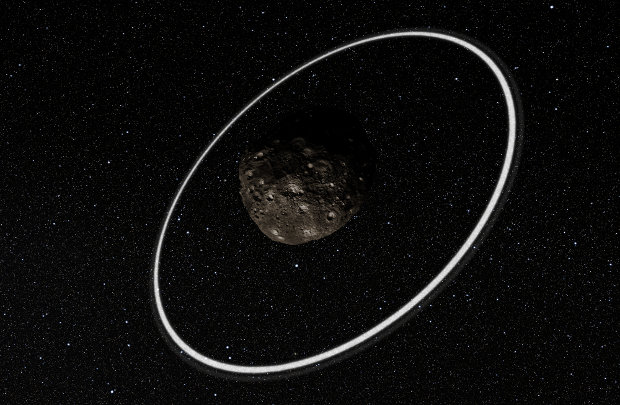
Seven astronomical observatories in South America, including the 1.54-meter Danish telescope and the TRAPPIST telescope at ESO’s La Silla Observatory, allowed to discover that the asteroid 10199 Chariklo has two rings of dust and other particles. So far, rings have been found only around the major planets: Jupiter, Saturn, Uranus, and Neptune. This discovery was reported in an article published in the journal “Nature”.
Discovered in 1997, Chariklo is a centaur asteroid, which means that it belongs to a class of icy planetoids that orbit between Jupiter and Neptune. Those orbits are unstable due to the proximity of the two planets so it’s likely that after a few million years a centaur is torn out of its orbit.
Currently, Chariklo is the largest among the centaur asteroids with a diameter of about 250 kilometers (about 155 miles). In 1995 the asteroid 1995 SN55 was identified, which was bigger, but after a short time, astronomers lost track of it. Its orbit wasn’t necessarily altered, it’s just that even with today’s instruments it’s hard to keep track of celestial bodies that are so small and far away from us.
On June 3, 2013, Chariklo passed in front of the star UCAC4 248-108672 from the point of view of South America. This phenomenon, known as an occultation, allows much better observations of a celestial body thanks to the light in the background. It’s for that reason that seven telescopes of that continent were aimed at an asteroid that didn’t seem extraordinary.
Instead, astronomers got a surprise. A few seconds before and again a few seconds after the main occultation, there were two other apparent drop in the light intensity from the star UCAC4 248-108672, though very short. The only explanation was that something around Chariklo was blocking the light.
Astronomers compared the observations made in various sites to get a composite image due to the fact that their points of view were slightly different. The result is that they have been able to reconstruct the shape and size of the asteroid Chariklo but also establish the existence and characteristics of its two rings, respectively seven km (a little more than three miles) and three km (almost two miles) wide, separated by a clear gap about nine km (about five and a half miles) wide.
The origin of these rings is still a mystery. The only theory proposed so far is that they got formed following a collision that left debris in the form of dust. They must have been confined to two narrow rings by the presence of at least a small satellite. It may sound strange but even asteroids may have moons and the Chariklo’s one may be so small as to have escaped even the observations made last year.
The two rings have been provisionally called Oiapoque and Chuí, like two rivers in Brazil. They can illustrate a phenomenon similar to the one that, in a much larger scale, led to the birth of the Earth’s Moon and other satellites in the solar system. It’s possible that there are other celestial bodies in the solar system that have rings but it takes luck to be able to locate them. With Chariklo, the astronomers got lucky and made a very interesting discovery.
[ad name=”eBayUSUKAstronomy”]


Permalink
Permalink